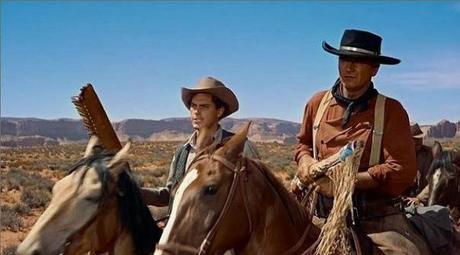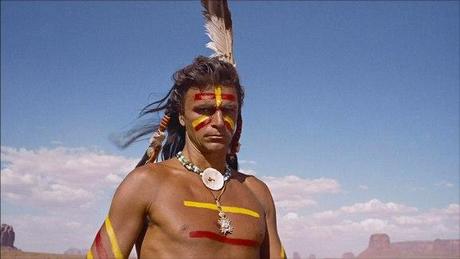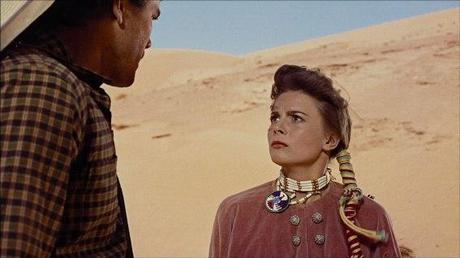 Jeffrey Hunter & John Wayne in The Searchers (1956)
Jeffrey Hunter & John Wayne in The Searchers (1956)Which of the many movies John Ford directed throughout his life can be called his greatest? Some critics might say The Grapes of Wrath, Young Mr. Lincoln, or How Green Was My Valley, while others may cite the Cavalry trilogy or The Man Who Shot Liberty Valance as the best examples of the director’s work.
For my money, however, it has got to be The Searchers from 1956 (based on the book by Alan Le May), a grandiose statement of Shakespearean proportions in its careful use of language (sometimes stoic, sometimes overly descriptive), locale (Monument Valley, Utah), comic relief to dissipate the rising tension (the loony bird Mose, the Jorgenson clan, the feud between Martin and Charlie McCorry for the affections of Laurie Jorgenson, and the preacher-turned-Texas Ranger Captain Clayton), and, of course, supremely memorable characterizations, the finest of which is John Wayne’s.
Wayne gives a towering performance as Ethan Edwards, a man obsessed with rescuing his kidnapped niece, Debbie (Lana Wood as a child, big sister Natalie Wood as a teenager), from the arms of a Comanche Indian chief named Scar (the ageless Henry Brandon) who raided his brother Aaron’s prairie-like abode. Failing to realize that he himself is scarred by his past — not just from battle but with the taint of racism, and his fear and loathing of miscegenation — Ethan lives out his bigotry in a search for his lost soul. It seems that he and Chief Scar are both motivated by feelings of revenge for the atrocities perpetrated on their family and loved ones.

Ethan’s adopted nephew, Martin Pawley (Jeffrey Hunter, in another indelible portrait) — one-eighth Cherokee in his words, but nothing but a half-breed according to Uncle Ethan — acts as his conscience and guide through this minefield of hate and vengeance, a Jiminy Cricket trying to keep his uncle honest about his motives in their five-year-long search for Debbie. There’s a poetic rhythm and unmistakable melancholy to their journey, which twists and turns in the manner of Homer’s The Odyssey.
Ford wisely keeps the dialog to a minimum. For example, we merely sense Ethan’s unspoken feelings for his brother’s wife, Martha (Dorothy Jordan), a lost amour from his youth. Their fleeting looks and gestures say more than words can put together. The opening number, “What Makes a Man to Wander” (performed by the Sons of the Pioneers) states the story’s theme right from the outset — it reappears at the end, serving the same function as a Greek chorus in summarizing prior events:
What makes a man to wander?
What makes a man to roam?
What makes a man leave bed and board
And turn his back on home?
Ride away – ride away – ride away
Although the score is credited to the Austrian-born Max Steiner, the song was composed by Stan Jones, a sometime member of Ford’s stock company. But the true focus remains on Wayne’s character. Ethan eventually finds and brings Debbie back to civilization, but he cannot partake of the happy homecoming. He stands outside the doorway, forever apart, forever searching for his soul and lost in his own contemplative world as he walks slowly away. Ethan, as well as the viewer, instinctively knows the answer to the song’s query of what made this man turn his back on home.

One of Wayne’s greatest accomplishments on screen is the depth to which he was able to plummet to get at Ethan’s brooding demeanor, i.e., that of the rugged individualist wounded by society’s encroachment, who seeks redemption for his transgressions by doing that which most men refuse or are afraid to do; to face the hardships head-on, only to retreat into the background once their duty has been done.
Oddly, Ethan knows an awful lot about the Comanche’s culture and lifestyle, which opens up a whole series of questions as to how he gained such in-depth knowledge in the first place and why he has such hatred of the Indians.
Wayne also learned about single-mindedness from his own life experiences and in how fellow actor, Henry Fonda, treated the twisted martinet Lt. Col. Owen Thursday in Fort Apache (1948). In addition, he took aspects of his portrayals as Tom Dunson in Howard Hawks’ Red River (1948) and Captain Nathan Brittles from Ford’s She Wore a Yellow Ribbon to arrive at a composite of the anti-hero Ethan Edwards. The miracle of his performance is that Wayne manages to make a detestable bigot into a real personality — a warts and all portrait of a hateful man whose natural instincts for survival clash with his unconscious need for family.
Aided and abetted by his mentor “Pappy” Ford, John “Duke” Wayne dredged up the darkness that resided within his own psyche: he’s Lucifer after the fall, trying to regain a measure of his humanity; Odysseus after the wars, alone on the Western plains, pining for home and hearth; and Captain Ahab, driven to madness and obsession by his desire to even the score with those who annihilated his kinfolk.

The other cast members, all of them good, contribute mightily to the ambience of this classic Western saga. They include Ward Bond, Hank Worden, Ken Curtis, Harry Carry Jr., John Qualen, Olive Carey, Vera Miles, Antonio Moreno, Pippa Scott, and Warren Coy. Wayne’s son Patrick makes a cameo appearance as a Union recruit. Fess Parker was originally tapped for the role of Martin, but the Disney Studios refused to allow his participation since Parker was tied up with promotional duties as Davy Crockett, a part that Wayne later played in the self-directed The Alamo.
With outstanding location photography by Winton C. Hoch, and a concise screenplay by Frank Nugent (The Quiet Man, Fort Apache), The Searchers influenced scores of motion pictures, among them David Lean’s Lawrence of Arabia, George Lucas’ Star Wars series and Martin Scorsese’s Taxi Driver.
Copyright © 2015 by Josmar F. Lopes

